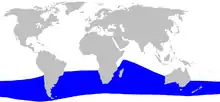Gray's beaked whale
Gray's beaked whale (Mesoplodon grayi), sometimes known as Haast's beaked whale, the scamperdown whale, or the southern beaked whale, is one of the better-known members of the genus Mesoplodon. This species is fairly gregarious and strands relatively frequently for a beaked whale. In the Māori language, this species is called hakurā or iheihe.[2]
| Gray's beaked whale | |
|---|---|
 | |
| Stranded individual | |
 | |
| Size compared to an average human | |
| Scientific classification | |
| Kingdom: | Animalia |
| Phylum: | Chordata |
| Class: | Mammalia |
| Order: | Artiodactyla |
| Infraorder: | Cetacea |
| Family: | Ziphiidae |
| Genus: | Mesoplodon |
| Species: | M. grayi |
| Binomial name | |
| Mesoplodon grayi von Haast, 1876 | |
 | |
| Gray's beaked whale range | |
Taxonomy
The species was first described in 1876 by Julius von Haast, director of the Canterbury Museum, Christchurch, New Zealand. He named it after the British taxonomist John Edward Gray, a zoologist at the British Museum. His description was based on three skulls he had received in May 1875 from a Louis Walter Hood Esq. (1837 – 11 February 1912, generally known as Walter) the storekeeper at Waitangi, who had retrieved them from three specimens that were part of a group of 28 individuals that had stranded on Waitangi Beach, Chatham Island, in the summer of 1874-75.[3]
Description

Gray's beaked whale is a fairly slender member of the genus. The melon on the whale bulges towards the blowhole and slopes down towards the beak. The beak itself is very long and pointed for a beaked whale, and has a relatively straight mouth line. In both sexes, 17–22 small teeth per row located towards the back of the mouth have been reported, but not confirmed. In males, two small, triangular teeth are present halfway down the mouth. The overall coloration is dark on top and light below, and both sexes have a white beak. Females are lighter on top and have additional white markings near the genitals. Adult males often carry linear scars that probably result from fighting, and both males and females may display circular scars from cookiecutter shark bites.[4] M. grayi are 5.5 to 6.0 m (18.0 to 19.7 ft) long and weigh around 1,100 kg (2,400 lb).[5] They are believed to be around 2.4 m (7 ft 10 in) long when born.
Behavior
_at_Port_Waikato.jpg.webp)
Gray's beaked whale is very gregarious. It has a tendency to strand in large groups, once involving 28 individuals. Other strandings involved five to eight animals. The upper teeth may be used in holding prey, but why only this species has them is not clear.
Gray's beaked whale is said to be the most common species of whale to beach in New Zealand.[6] Two whales that stranded themselves on Opape Beach in the Bay of Plenty, New Zealand, in December 2010, were initially thought to be Gray's beaked whales, but later found to be the very rare spade-toothed whale.[6]
Population and distribution
This species typically lives in the Southern Hemisphere between 30 and 45°, and is typically observed at depths of 2,000 m (6,600 ft).[5] Many strandings have occurred off New Zealand, but others have happened off Australia, South Africa, South America, and the Falkland Islands. This species has been sighted in groups off the coast of Madagascar and in the Antarctic area. Oddly, one specimen stranded off the Netherlands, in a different hemisphere and several thousand miles away from all other strandings. No population estimates exist, but they are believed to be rather common.
Conservation
These whales have not been hunted deliberately and they have not been entangled in fishing gear. Gray's beaked whale is included in the Memorandum of Understanding Concerning the Conservation of the Manatee and Small Cetaceans of Western Africa and Macaronesia (Western African Aquatic Mammals MoU) and the Memorandum of Understanding for the Conservation of Cetaceans and Their Habitats in the Pacific Islands Region (Pacific Cetaceans MoU)
Specimens
- MNZ MM002134 Gray's Beaked Whale Mesoplodon grayi, collected Black Reef, Cape Kidnappers, Hawke Bay, New Zealand, 18 March 1993.
See also
References
- Pitman, R.L. & Taylor, B.L. (2020). "Mesoplodon grayi". IUCN Red List of Threatened Species. 2020: e.T13247A50366236.CS1 maint: multiple names: authors list (link)
- http://www.teara.govt.nz/en/te-whanau-puha-whales/page-1
- "On a New Ziphioid Whale. By Julius von Haast, Ph.D. F.R.S., Director of the Canterbury Museum, Christchurch, New Zealand. Communicated by Prof. W. H. Flower, F. R.S." Proceedings of the Zoological Society of London (January, 1876), pp. 7-13.
- Gray's Beaked Whale, Australian Museum. Updated 13 October 2009. Retrieved 13 January 2011.
- Wang, Arthur. "Mesoplodon grayi Gray's beaked whale". Retrieved 18 October 2014.
- Satherley, Dan (6 November 2012). "World's rarest whale stranded on NZ beach". 3 News NZ.
Bibliography
External links
| Wikimedia Commons has media related to Mesoplodon grayi. |
- Factsheets - Gray's Beaked Whale
- Cetaceans of the World
- CMS
- Whale & Dolphin Conservation Society (WDCS)
- Memorandum of Understanding Concerning the Conservation of the Manatee and Small Cetaceans of Western Africa and Macaronesia.
- Official webpage of the Memorandum of Understanding for the Conservation of Cetaceans and Their Habitats in the Pacific Islands Region
